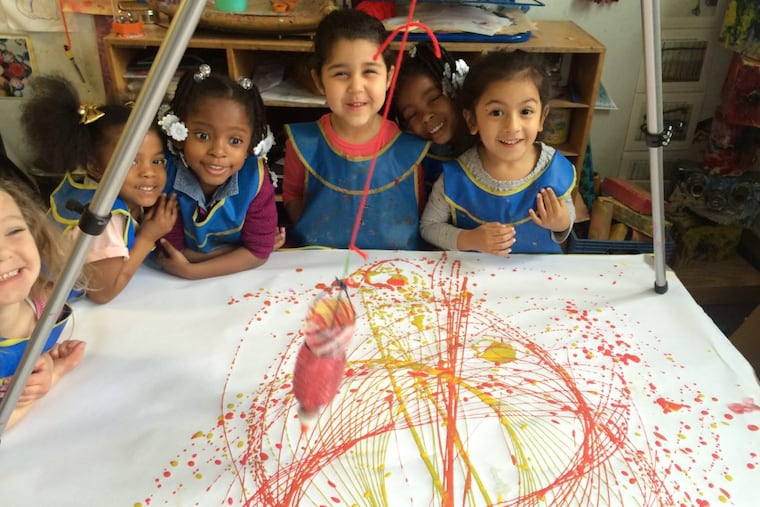How can the arts benefit kids from disadvantaged neighborhoods?
Learn more about the Kaleidoscope Preschool Arts Enrichment Program at Settlement Music School.

With the recent buzz around teaching STEM concepts to our children, it shouldn't be forgotten how the arts plays a role in enhancing the learning experience as well. One such program that teaches preschool kids using an arts-integrated approach is the Kaleidoscope Preschool Arts Enrichment Program at Settlement Music School. The Greater Philadelphia Cultural Alliance recently awarded Kaleidoscope with its Pre-K Excellence Award.
We asked Tarrell Davis, Director of Early Childhood Programs, Settlement Music School, to tell us more about the program and Eleanor Brown, PhD , Professor of Psychology, West Chester University, about her research that suggested the program reduced the stress levels of its students.
What is Kaleidoscope?
TD: Kaleidoscope began in 1990 at Settlement Music School's Mary Louise Curtis Branch to serve a community need for childcare. Because of Settlement's expertise in music education, we decided to teach children through music. This teaching was so successful that shortly after came visual art and creative movement classes. We currently serve more than 80 students at our Mary Louise Curtis Branch, and 30 more children at our Germantown Branch.
The Kaleidoscope artist teachers and the early childhood teachers plan creative lessons together for homeroom and arts classes that reinforce cognitive skills, fine and gross motor skills, as well as science, literacy, and math skills. We teach these skills through school readiness concepts including patterns, change, and spatial awareness. What's more, Kaleidoscope teachers intentionally address self-help skills, problem solving skills, and social skills within their day-to-day interactions with the children. The skills we are teaching children carry them through life.
What does research about the program tell us?
EB: This research suggests that high quality arts programming can decrease stress levels for children facing economic hardship. In comparison to regular homeroom classes, music, dance, and visual arts related to lower levels of the stress hormone cortisol. This is a meaningful finding, particularly for economically disadvantaged children, who are disproportionately likely to face dangerous or chaotic neighborhoods and frequent residential moves, as well as family financial strain.
In the ideal world, no child would grow up with economic hardship. As we work toward this ideal, it is important to identify mechanisms for alleviating the impact of poverty. We now have evidence that the arts can "get under the skin" and lower children's stress levels.
How did the effects of lowered cortisol change during the four year study?
EB: We studied 310 children who attended Settlement's Kaleidoscope Preschool over the course of four years. We measured children's cortisol at four different times during the school day, on two different days of the week, at the start, middle, and end of the school year.
The pattern of lower cortisol after arts classes was not apparent at the start of the year but emerged in the middle of the year and was maintained at year's end. It may be that certain physiological benefits of these arts classes depend on children's adjustment or accumulated skill acquisition. To experience certain self-regulatory benefits of the arts, for example, children may need to first acquire particular artistic skills. Notably, we found the same pattern of lower cortisol levels after music, dance, and visual arts classes, suggesting similar benefits of multiple arts modalities.
How did the study design account for other factors that could affect decreases in stress levels?
EB: Yes. Children were randomly assigned, based on preschool class, to different schedules of arts and homeroom classes on different days of the week, which allowed us to control for the impact of time of day on cortisol. Even after accounting for this impact, participation in an arts class related to lower stress levels.
The arts classes may have differed from homeroom along dimensions not measured in the present investigation, such as the proportion of teacher-directed activities, individual versus group activities, fine versus gross motor activities, or teaching quality. Future studies could control for such components and identify the "active ingredients" in the arts classes. The similar effects for music, dance, and visual arts, however, suggests the potential power of the arts for lowering children's stress levels.
How can school educators enhance their arts curriculum to further benefit kids?
TD: I believe that people who teach preschool are intrinsically very creative people—you have to be! If arts are integrated in approaching, say, a science lesson, I think that we will have stronger outcomes for our children and level the playing field.
For example, at Kaleidoscope for our 3-to 5-year-olds we infuse music and science in a lesson where our children are learning about liquids and volume by using an exploratory approach. Teachers and students fill aluminum bowls with varying amounts of water, and students run their fingers around the edges to help them distinguish sounds in correlation to the amount of liquid in each bowl. They discuss high pitch versus low pitch along with the concept of volume. They then extend the learning by creating songs using their singing voice to try and match each pitch, thus bringing the science lesson to life in a musical way. Using the arts can uncover newfound capabilities in both teacher and student.